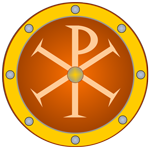
Battle of Bitola(Battle of Voutelion or of Pelagonia) |
year: 1015 |
| Annihilation of a strong Byzantine force by the Bulgarians | ★ ★ ★ ★ ★ |
|
enemy: Bulgarians
|
location: Near Voutelio, present-day Bitola in North Macedonia
|
accuracy:
●●●●●
|
|
battle type: Ambush |
war: Conquest of Bulgaria |
modern country:
North Macedonia |
| ▼ The Byzantines(emperor: Basil II Bulgaroktonos) | ▼ The Enemies | |
| Commander: | Georgios Gonitziatis, Orestes | Ivats |
| Forces: | ||
| Losses: |
| Background story: |
| In 1014, after the great victory of the Byzantines at Kleidion on July 29 and the death of Tsar Samuel in October, the Bulgarians were in a very difficult position. The Byzantines now had the initiative and the emperor Basil II was invading constantly into enemy territory, managing to capture important cities and fortresses such as Voutelion (Bitola), Vodena (Edelsa), and Moglena. Especially the loss of Moglena, caused turmoil in Bulgaria and resentment against the successor of Samuil Gabril Radomir who was unable to organise a resistance against the Byzantines.
At the same time, Basil made efforts to persuade the Bulgarians to capitulate. Gabril Radomir was considering a treaty with the Byzantines, but finally he was not so cooperative. In August 1015 he was assassinated by his cousin Ivan Vladislav who became tsar in his place. The new tsar, despite the expectations of the Byzantines and despite initially sending a letter of submission to Basil II, began to organize his defense and was making efforts to motivate his discouraged compatriots. The ambiguous attitude of Vladislav did not deceive the Byzantines for a long time. The emperor campaigned again very soon, within the same year. The Bulgarians were unable to resist and took refuge in the mountains and remote fortresses. The Byzantine army proceeded by sweeping the provinces of Ostrovo and Pelagonia and blinding all the Bulgarians taken prisoners. The next objective was Ohrid, the capital of Bulgaria. |
The Battle: |
 Statue of Ivats in Sofia However, the Bulgarians, led by the voivode Ivatz trapped this army somewhere near Vitolia (today's Bitola, formerly Monastirion) and killed them all. Emperor Basil, who in the meantime had occupied Ohrid (but not the citadel of the city), when he heard the news, he returned to Pelagonia to pursue Ivatz who avoided getting engaged in battle. The emperor returned to Thessaloniki and from there to Mosynopolis, from where he organized the mission of two other expeditionary corps: one under David Arianitis to Stroumitsa, which this time was captured, and the other led by General Xifias in the area of Triaditsa (Sofia), where he captured the fortress of Boyana. In January 1016 the emperor returned to Constantinople. |
Aftermath: |
| The battle caused unexpected losses to the Byzantines and revived for a while the morale of the Bulgarians. Thus, it delayed the final Byzantine victory but did not change the course of the war. Ohrid was immediately recaptured by the Bulgarians. If Ohrid had been occupied and the Byzantines remained there, the war would probably have ended in 1015. The following year the fighting resumed. Ivatz in 1018 was the last leader of the Bulgarian resistance. |
|
|
